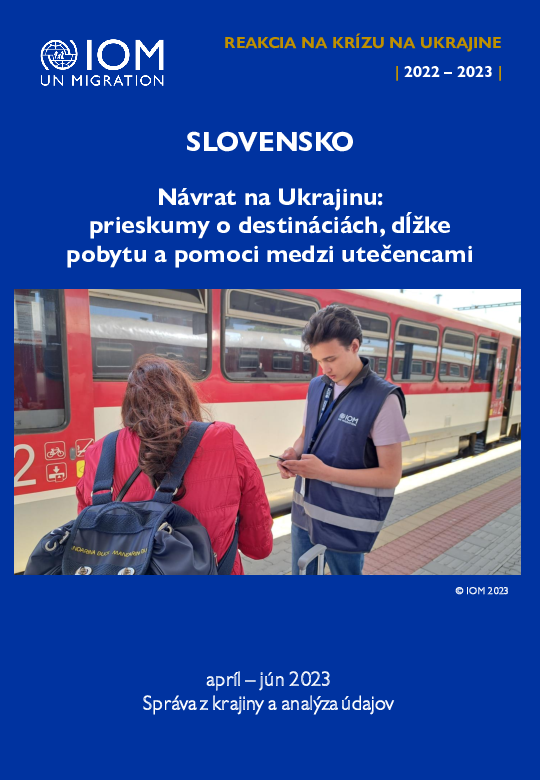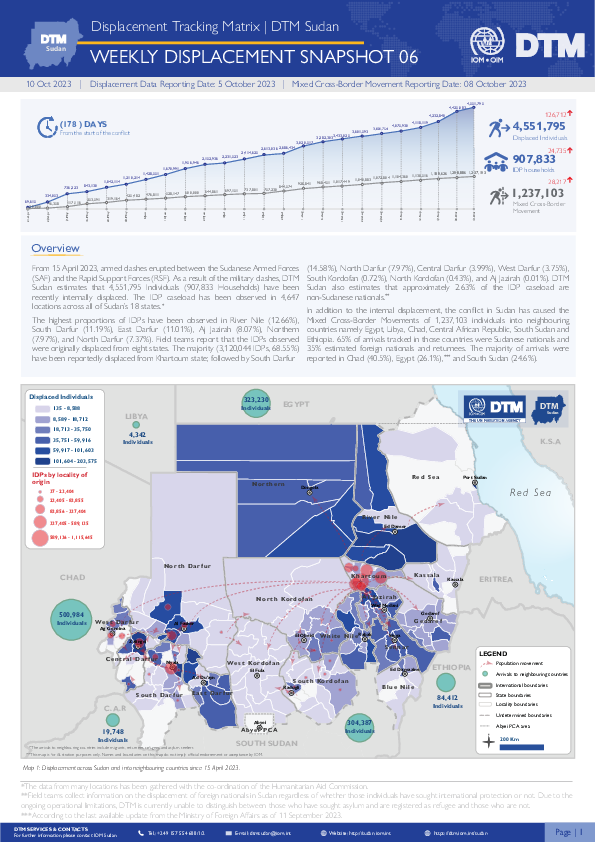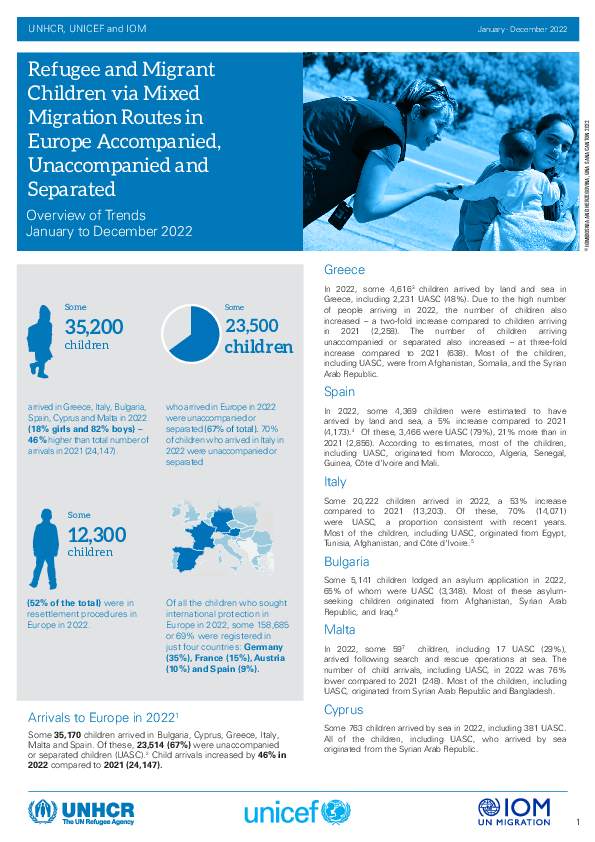-
Countries
-
Data and Analysis
-
Special Focus
-
Crisis Responses
Assessment Report
Contact
DTM Libya, DTMLibya@iom.int
Language
English
Location
Libya
Snapshot Date
Oct 31 2019
Activity
- Mobility Tracking
- Site Assessment
Detention Centre Profiling is a component of IOM Libya’s Displacement Matrix programme. It is a data-oriented tool that routinely provides specific sex and age demographic data and key sectorial information on individuals held in Libya’s detention Centres on the date of assessment.
Contact
DTM Libya, DTMLibya@iom.int
Language
English
Location
Libya
Snapshot Date
Sep 30 2018
Activity
- Mobility Tracking
- Site Assessment
Detention Centre Profiling is a component of IOM Libya’s Displacement Matrix programme. It is a data-oriented tool that routinely provides specific sex and age demographic data and key sectorial information on individuals held in Libya’s detention Centres on the date of assessment.
Contact
DTM Libya, DTMLibya@iom.int
Language
English
Location
Libya
Snapshot Date
Aug 31 2018
Activity
- Mobility Tracking
- Site Assessment
Detention Centre Profiling is a component of IOM Libya’s Displacement Matrix programme. It is a data-oriented tool that routinely provides specific sex and age demographic data and key sectorial information on individuals held in Libya’s detention Centres on the date of assessment.

Contact
DTM South Sudan, SouthSudanDTM@iom.int
Language
English
Location
South Sudan
Period Covered
Mar 01 2023
Apr 30 2023
Activity
- Mobility Tracking
- Baseline Assessment
This atlas contains a summary of findings from the fourteenth round of Mobility Tracking conducted across South Sudan through key-informants based assessment at location level between March and April 2023. Mobility Tracking quantifies the presence of internally displaced persons (IDPs) and returnees in South Sudan in displacement sites and host communities. IOM DTM mapped a total of 2,027,331 IDPs (including 8% previously displaced abroad) and 2,335,604 returnees (including 27% from abroad) in 3,916 locations across South Sudan as of April 2023.

Contact
DTM Europe, DTMMediterranean@iom.int
Language
English
Location
Slovakia
Snapshot Date
Jun 30 2023
Activity
- Survey
- Return Intention
Utečenci z Ukrajiny a štátni príslušníci tretích krajín (ŠPTK) od 24. februára 2022 utekajú do susediacich krajín pred vojnou. K júlu 2023 bolo v Európe zaznamenaných takmer šesť miliónov utečencov. Okrem toho od februára 2022 prekročilo hranice Ukrajiny do susediacich krajín viac ako 20 miliónov utečencov a migrantov z Ukrajiny alebo tretích krajín.
IOM v polovici apríla 2022 nasadila svoj nástroj Displacement Tracking Matrix (DTM) určený na monitorovanie vysídlených osôb. Pomocou neho sa zbierajú údaje v prieskumoch jednotlivcov v krajinách susediacich s Ukrajinou pri tom, ako prekračujú hranicu späť na Ukrajinu. Jeho cieľom je zlepšiť pochopenie profilov, vzorcov vysídlenia, zámerov a potrieb tých, ktorí sa tam vracajú. Táto správa je založená na prieskumoch zozbieraných na Slovensku v období od 10. apríla do 30. júna 2023 v Bratislave a Košiciach na tranzitných bodoch (vlakových a autobusových staniciach) od osôb smerujúcich priamo na Ukrajinu.

Contact
IOM Guyana, IOMGuyana@iom.int
Language
English
Location
Guyana
Period Covered
Mar 19 2023
Mar 28 2023
Activity
- Survey
- Flow Monitoring
The economic crisis in the Bolivarian Republic of Venezuela (hereinafter referred to as Venezuela) has resulted in the massive displacement of Venezuelan nationals throughout Latin America and the Caribbean. To clearly understand the impact of this crisis on Venezuelan nationals residing in these countries, the International Organization for Migration (IOM) has been conducting Displacement Tracking Matrix (DTM) exercises across the globe. The objective of DTM is to capture data on various humanitarian needs such as protection, health, education, integration, food security, shelter, mental health, and the like to establish population profiles, track movements, map routes, and identify entry and exit points.
Since 2018, IOM Guyana has been conducting DTM activities on Venezuelan nationals. This 2023 DTM is the first conducted strictly on Indigenous Venezuelan nationals. The IOM team of enumerators worked with key informants and government officials to identify flow monitoring points where Indigenous migrants reside. Enumerators interviewed one member from each household and used snowball sampling to capture as many households as possible. From March 19 - 28, 2023, 162 interviews were conducted in regions 1, 2, 7, and 9.

Contact
DTMUkraine@iom.int
Language
English
Location
Ukraine
Period Covered
Sep 03 2023
Sep 25 2023
Activity
- Survey
Since March 2022, following the full-scale invasion of Ukraine by the Armed Forces of the Russian Federation, the International Organization for Migration (IOM) has been collecting data on internally displaced persons (IDPs), returnees, and the nondisplaced population through a nationwide survey. Starting with Round 13, the General Population Survey methodology was adjusted to provide oblast-level representative data, with 20,000 randomized interviews conducted in each round.
This snapshot report offers an initial overview of population figures and the geographic distribution of displaced and returnee populations as of September 25, 2023. In Round 14, population estimates were based on the new UNFPA population baseline for Ukraine (eq. 33M in August 2023), excluding the Autonomous Republic of Crimea and Sevastopol, shown by a grey dotted line in Figure 1. R13 used the UNFPA baseline from May 2023 (41M), also excluding the Autonomous Republic of Crimea and Sevastopol, marked by a yellow dotted line. Rounds 1-12 used a baseline population of 44M for IDPs, including the Autonomous Republic of Crimea and Sevastopol. In Rounds 1-13, the returnee baseline was ≈30 million, considering the subtraction of the IDPs and people abroad (UNHCR). This change in the baseline scenario contributes to the adjustments of the est. total numbers of IDPs and returnees.

Contact
DTM Sudan, DTMSudan@iom.int
Language
English
Location
Sudan
Snapshot Date
Oct 05 2023
Activity
- Mobility Tracking
- Baseline Assessment
Overview
From 15 April 2023, armed clashes erupted between the Sudanese Armed Forces (SAF) and the Rapid Support Forces (RSF). Clashes initially took place in cities across Northern and Khartoum states, later spreading across the Darfur and Kordofan regions.
Key Findings
- DTM Sudan estimates that 4,551,795 Individuals (907,833 Households) have been recently internally displaced.
- The IDP caseload has been observed in 4,647 locations across all of Sudan’s 18 states.
- The highest proportions of IDPs have been observed in River Nile (12.66%), South Darfur (11.19%), East Darfur (11.01%), Aj Jazirah (8.07%), Northern (7.97%), and North Darfur (7.37%).
- Field teams report that the IDPs observed were originally displaced from eight states. The majority (3,120,044 IDPs, 68.55%) have been reportedly displaced from Khartoum state; followed by South Darfur (14.58%), North Darfur (7.97%), Central Darfur (3.99%), West Darfur (3.75%), South Kordofan (0.72%), North Kordofan (0.43%), and Aj Jazirah (0.01%).
- IOM DTM also reports that an estimated 1,237,103 mixed cross-border movements have been made into neighbouring countries.
- Some 35,200 children arrived in Greece, Italy, Bulgaria, Spain, Cyprus and Malta in 2022 (18% girls and 82% boys) – 46% higher than total number of arrivals in 2021 (24,147).
- Some 23,500 children who arrived in Europe in 2022 were unaccompanied or separated (67% of total). 70% of children who arrived in Italy in 2022 were unaccompanied or separated
- Some 12,300 children (52% of the total) were in resettlement procedures in Europe in 2022.
- Of all the children who sought international protection in Europe in 2022, some 158,685 or 69% were registered in just four countries: Germany (35%), France (15%), Austria (10%) and Spain (9%).

Contact
DTMBurundi@iom.int
Language
English
Location
Burundi
Period Covered
Mar 01 2023
Sep 30 2023
Activity
- Survey
En décembre 2022, une évaluation a été menée auprès des informateurs-clés pour renseigner sur la stabilité de 50 collines où se trouvent concurremment un grand nombre de personnes déplacées internes (PDI) et rapatriées provenant de six communes de la province de Makamba. Cet exercice nous a permis de déterminer, pour chaque colline, un score sur l’indice de stabilité (voir annexe 8.2). Cette méthode de collecte d’information est basée sur les perceptions d’informateurs-clés et peut donc être subjective aux informateurs eux-mêmes. En tenant compte de cette limitation et pour compléter les résultats de l’indice de stabilité, une évaluation du progrès vers une solution durable (voir annexe 8.2) a été menée auprès des ménages des collines de Mugumure, Muyange et Rangi à Nyanza-Lac. Cette évaluation a permis de comprendre les raisons qui sous-tendent le choix des lieux de retour ou de déplacement et les obstacles potentiels à la stabilisation des communautés accueillant les PDI et les rapatriés.
Pagination
- Previous page
- Page 71
- Next page

